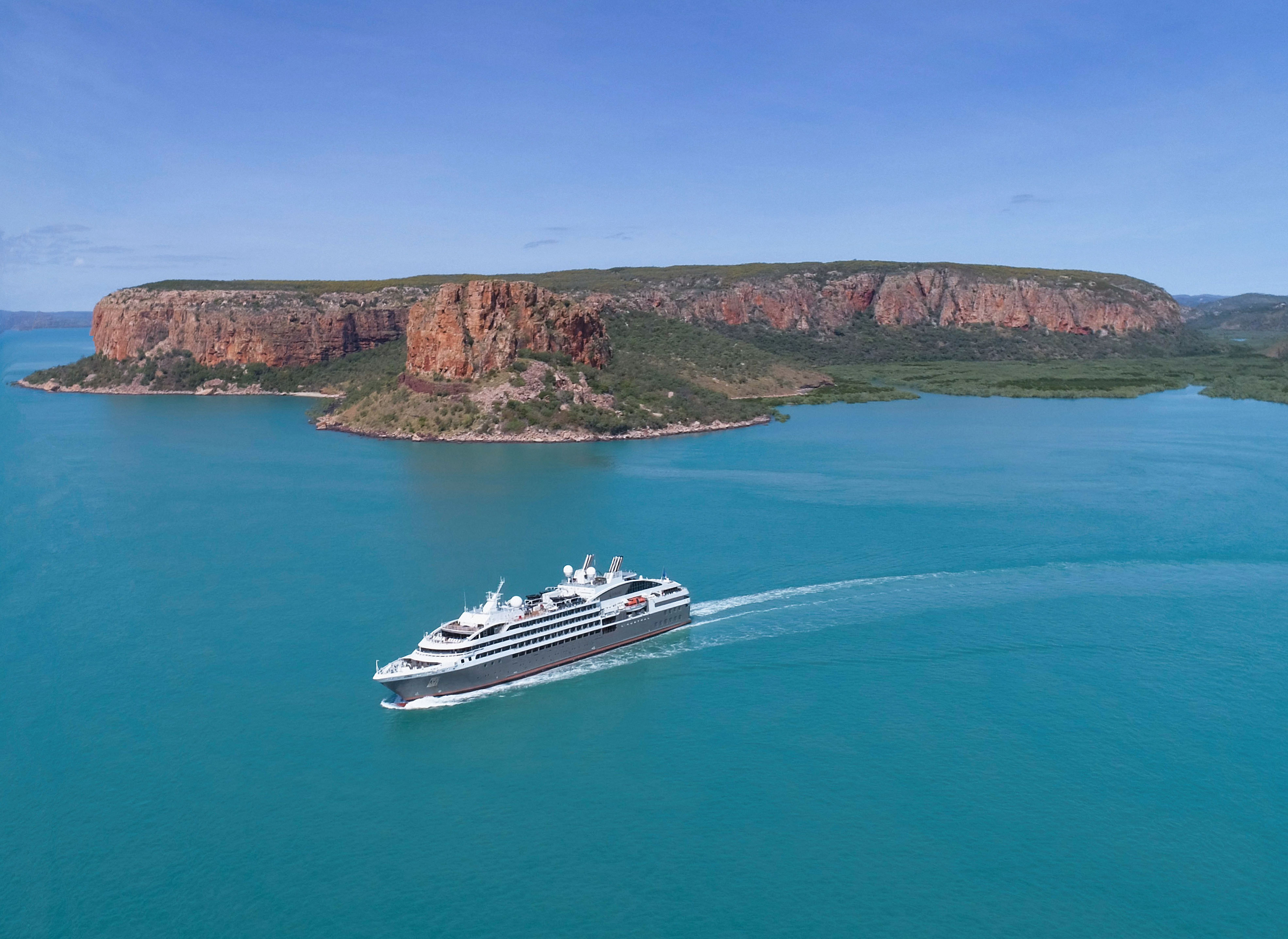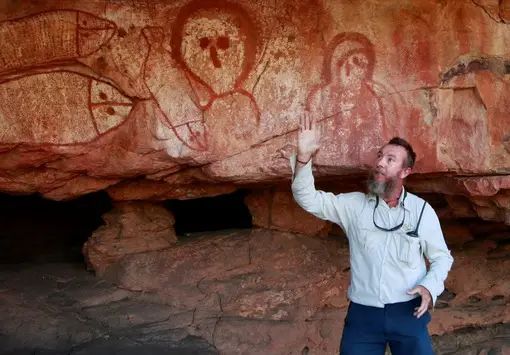Top Things to See on a Cruise in the Kimberley, Australia
Western Australia’s Kimberley region is one of Australia’s most remote and wild landscapes. The Kimberley region is found between Broome and Darwin in the northwest corner of Australia, a region that can be experienced by taking the adventurous and sometimes dangerous Gibb River Road or by a much more scenic and relaxing cruise. Cruise ships offer the added benefit of allowing visitors to see the especially hidden corners and rarely seen natural wonders of the Kimberley Region.
It may be one of Earth’s least densely populated regions when it comes to human inhabitants, but the Kimberley abounds with wildlife inhabitants both of the marine and terrestrial variety. The region is also home to unique natural wonders including horizontal flowing waterfalls and a wealth of significant indigenous rock art sites.
Cruising through Australia’s expansive Kimberley allows you to witness many of the thousands of islands in the region and provides you with the chance to partake in a number of thrilling activities such as fishing for barramundi, swimming in refreshing water holes, and taking helicopter rides over the waterfalls.
We’ve gathered a list of some of the top things to see on a cruise in the Kimberley, one of the first settled parts of Australia that combines the vastness of the Australian Outback with the beauty of the Indian Ocean. In addition to providing you with insight on what you can experience in the region, we’ll also offer some helpful tips for exploring one of Australia’s most fascinating destinations.
kimberley-cruise-Mick Fogg © PONANT
Benefits of Cruising the Kimberley
As stated previously, some areas of the Kimberley can be accessed via road, however, a Gibb River Road journey through the Kimberley can be arduous and is only suitable for rugged 4WD vehicles during the driest period of the year. Visitors choosing a land-based journey must have extensive knowledge of the Outback and must be ready to endure potential harsh conditions with few facilities.
While a great deal of planning and preparation is needed for land-based Kimberley expeditions, you can easily book a cruise online and allow all the planning and hard work to be done by knowledgeable experts. No need to worry about booking accommodation each night, cooking meals, or mapping out where the best attractions are. This allows you to focus more on the stunning landscapes and attractions that the region has to offer.
Cruises allow you to witness this rugged untamed region while not having to sacrifice on comfort. Many Kimberley cruises are small-ship excursions offering personalized service and luxurious staterooms and suites with private balconies to take in the never ending views. Cruise ships are equipped with zodiac boats which will take you and local naturalist guides into the most remote regions of the Kimberley to see places only few eyes have seen, combining both land and sea based points of interest.
kimberley-cruise-king-george-river-© Ponant
Top 10 Things to See on a Kimberley Cruise
Mitchell Falls
Roughly 80 meters tall across its four beautiful tiers, Mitchell Falls is one of the Kimberley’s most impressive waterfalls. Situated within Mitchell River National Park, the falls are known as Punamii-unpuu to the local Aboriginal Wunambal people. The area offers more than just Mitchell Falls, as there are Aboriginal rock art sites, the popular Surveyors Pool, and the nearby Little Mertens Falls to check out as well. The area is also a hot spot for bird life, with hundreds of species being recorded at the site.
King George Falls
Western Australia’s largest falls, King George Falls are twin falls that featured in the Hollywood blockbuster film Australia with Hugh Jackman and Nicole Kidman. Known as the Rainbow Serpents by the local Balanggarra Aboriginal people, the falls plummet some 50 meters in a single drop. The falls are set to backdrop of red gorges and ancient sandstone cliffs.
Horizontal Falls
While most waterfalls drop vertically, the aptly named Horizontal Falls flow sideways. Found in Talbot Bay, Horizontal Falls are created from the dramatic tidal shifts being compressed between the surrounding cliffs. David Attenborough called the falls “one the greatest natural wonders of the world”. The falls can flow in both directions, its direction being determined by whether the tide is coming in or going out. The tidal variation can be as dramatic as 10 meters and the falls can be witnessed by both helicopters and speed boats.
King George River Kimberley©Studio Ponant-Morga…Monneret
Bungle Bungle Range
A scenic flight is the best way to experience the beehive-shaped sandstone rock formations found in the Bungle Bungle Range. Kimberley cruises often incorporate the opportunity to take a scenic flight to the area which is found within the World Heritage Site known as Purnululu National Park. Formed over 360 million years ago, the region was largely unknown to the outside world until the 1980s. Before this time, only the local Aboriginals knew of the Bungle Bungle’s significance.
Broome
Often the starting or ending point for Kimberley expeditions, Broome is the largest town found within the Kimberley. While it may be the gateway to the Kimberley, Broome is home to a number of remarkable attractions itself. The westward-facing Cable Beach allows for incredible Indian Ocean sunset viewing which can only be enhanced by riding on the back of a camel. Learn about pearl farming, dine of freshly caught barramundi, and walk in the footsteps of dinosaurs as you check out the fossilized footprints of the Jurassic beasts that once ruled the region. Birdwatchers may wish to seek out shorebirds at Roebuck Bay.
El Questro Wilderness Park
Covering roughly 700,000 acres, El Questro Wilderness Park offers an abundance of hiking and horseback trails. The park is home to Emma Gorge and its towering waterfall, as well as the soothing Zebedee Thermal Springs. Visitation to this wilderness area is regulated and wilderness permits must be purchased by visitors. The El Questro Cattle Station continues to be a working cattle station, handling up to 6,000 head of cattle. Other great hikes within the park include the El Questro Gorge Trail, the Amalia Gorge Trail, and walks along the Pentecost River.
Montgomery Reef
Spanning more than 400 square kilometres, Montgomery Reef stretches 80 kilometers in length off the Kimberley coast. A great diving spot due to its numerous shipwrecks, Montgomery Reef undergoes a dramatic change as the tides go in and out each day. Parts of the reef become visible during low tide, which in turn attracts scores of wading birds and marine life. Giant but gentle dugongs, snubfin dolphins, sea turtles, and black tipped reef sharks all inhabit these waters.
Lacepede Islands
Once popular as guano mining islands, the Lacepede Islands are four islands found off the northwest coast of the Kimberley Region within Montgomery Reef. Visiting these islands provides the chance to spot a number of sea birds including brown boobies, pelicans, and giant frigatebirds. The surrounding waters are also home to dwarf fin whales, shovel-nose rays, and green sea turtles.
Buccaneer Archipelago
An archipelago consisting of nearly 1,000 rocky islands, the Buccaneer Archipelago is home to giant saltwater crocs, sea snakes, and several shark species. Cockatoo and Koolan Islands have been mined throughout history for its richness of iron ore and many other islands contain the graves of early sailors who perished in the sometimes treacherous waters. Zodiac boats now take visitors around the islands to view the rich fauna and Aboriginal rock art sites.
Jar Island
Once home to the Macassan peoples of Indonesia, Jar Island still contains artefacts that tell the story of their habitation here. Potsherds and ancient stoves once used to cook sea cucumbers were uncovered here and the island also contains a wealth of Bradshaw style Aboriginal art that dates back as far as 20,000 years. Some of the region’s most impressive rock art sites are found on islands such as Jar Island as well as Bigge Island and Raft Point. Most of these sites are only accessible by boat and include artwork that portrays human and anthropomorphic figures as well as hand motifs.
mark-harry christensen-guide-aboriginal-art-© Ponant
Best Time to Enjoy a Kimberley Cruise
The monsoon season occurs during summer and early spring, making travel through the region rather difficult. Most cruises offer journeys from May-August when the threat of cyclones diminishes and flights to the Kimberley are more frequent. To catch the area’s numerous waterfalls in full force, booking a cruise at the start of the dry season is recommended.
While the Kimberley can reach temperatures of over 100 °F, travelling during the cooler and drier months will see you experiencing highs only reaching into the 80s. The dry season is the best season to witness local Australian wildlife that become more concentrated around water sources, and most areas of national parks will be opened. Keep an eye out for wild dingoes, red-tailed black cockatoos, bilbies, bandicoots, quolls, comical frill-necked lizards, and rock wallabies. Of course you are also likely to spot the real stars of the region, both the freshwater and saltwater crocodiles.
Top Banner Image Provided By : kimberley-cruise-©PONANT
Post Featured image provided by: kimberley-cruise-Mick Fogg © PONANT























